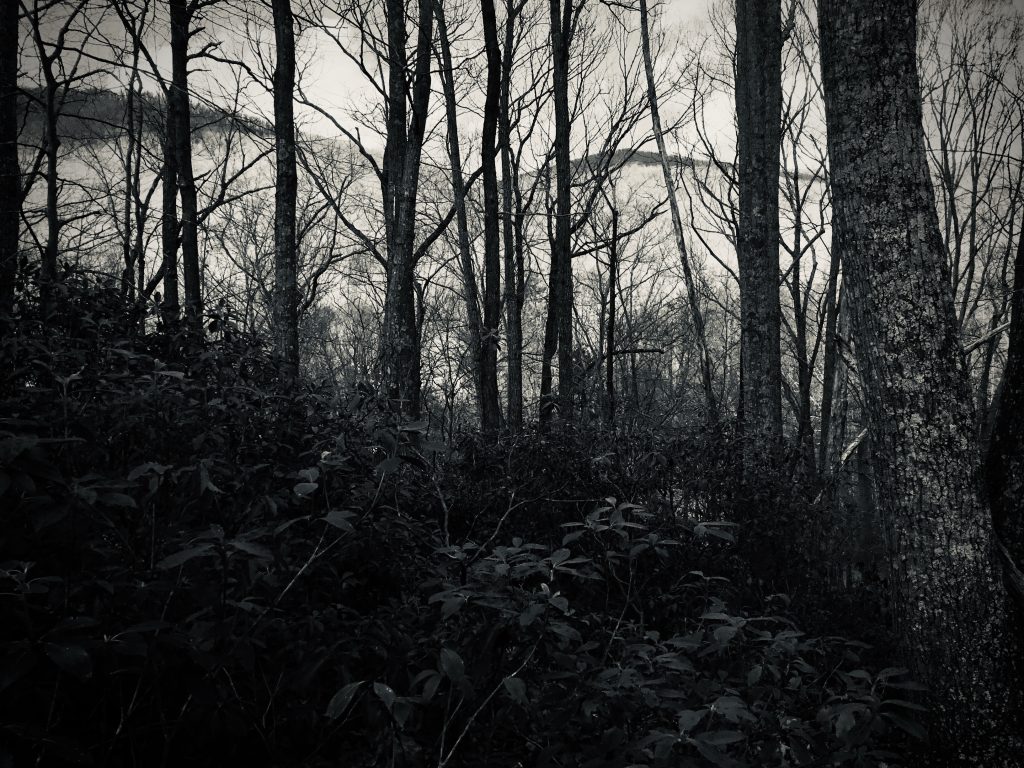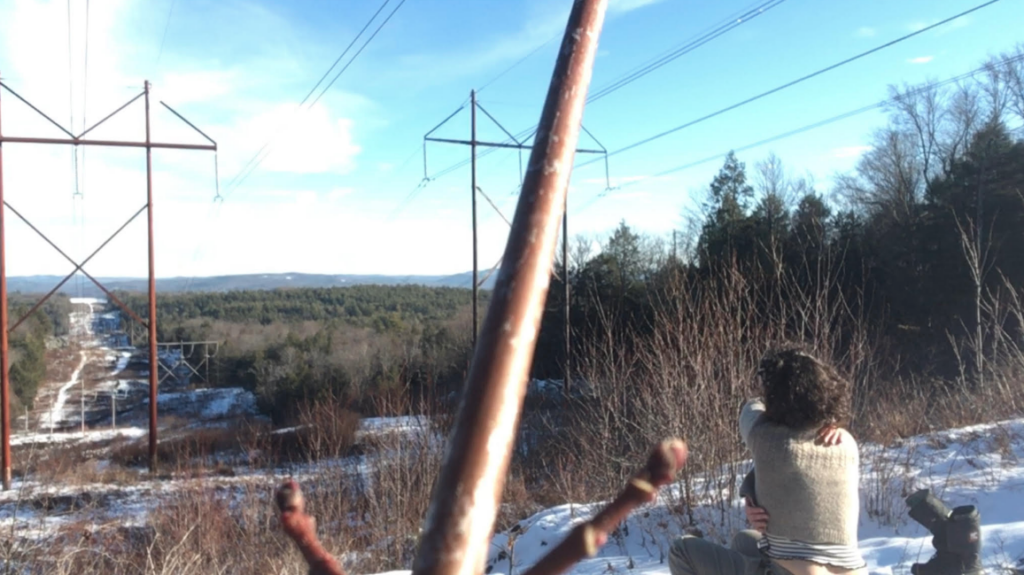Or, Vespula Vespers
Or, Underworld Negotiations and My Nervous System
“Before he had a Roman name, Pluto was Hades, the Greek ruler of the underworld. Hades was the most prominent of several chthonic gods (“chthonic” translates to “under the earth”) who were associated both with the spiritual realm of the dead, and with the physical earth/ground…The Eleusinian Mysteries, a secretive initiation ceremony held for centuries, centered on the chthonic myth of Persephone, who is kidnapped to the underworld by Hades, and her mother Demeter, who fights for Persephone’s return. The initiation itself was described as a journey into the underworld, followed by a return to the light. Chthonic gods were not portrayed as evil, but they were feared; or, one might say, they were held in healthy respect. Because he was the ruler of the underworld, Hades in particular was treated with deference: the Greeks didn’t like to say his name. When they needed to refer to him, they used the word Plouton, which means “riches” — an agricultural allusion to the riches in the soil of the earth. As time passed and Roman culture usurped dominance from the Greeks, language evolved, and the god of the underworld came to be called Pluto, with the term Hades referring to the underworld itself. Pluto had both the positive association of the mineral riches contained in the earth, and the more fearsome role as ruler of the dead. He was quick to anger if anyone tried to cheat death or escape from the underworld, but aside from that, he was usually indifferent to human affairs. He was known for a passive fairness, a quality that matches the impersonal nature of the Pluto archetype. There is a deep resonance between death/the dead, and soil, or deep earth. All bodies go back to the earth, nourishing the soil. Death creates life. Pluto, ruler of the underworld, is responsible for this ongoing metamorphosis; it is something that belongs to him…Not only will our bodies return to the earth; they are servants to the expansion of life itself, the irrepressible urge towards macrocosmic survival. Pluto is evolution — the genetic force that drives life to flourish into its infinitely varied expressions. And physical death is the flip side of that coin, a necessity for the continuation of life. If individual bodies didn’t die, genetic adaptation would be impossible. The rich soil of ongoing survival, from which life springs, is nourished by microcosmic death.”
–Hummingbird Star, “The Pluto Return of the USA“
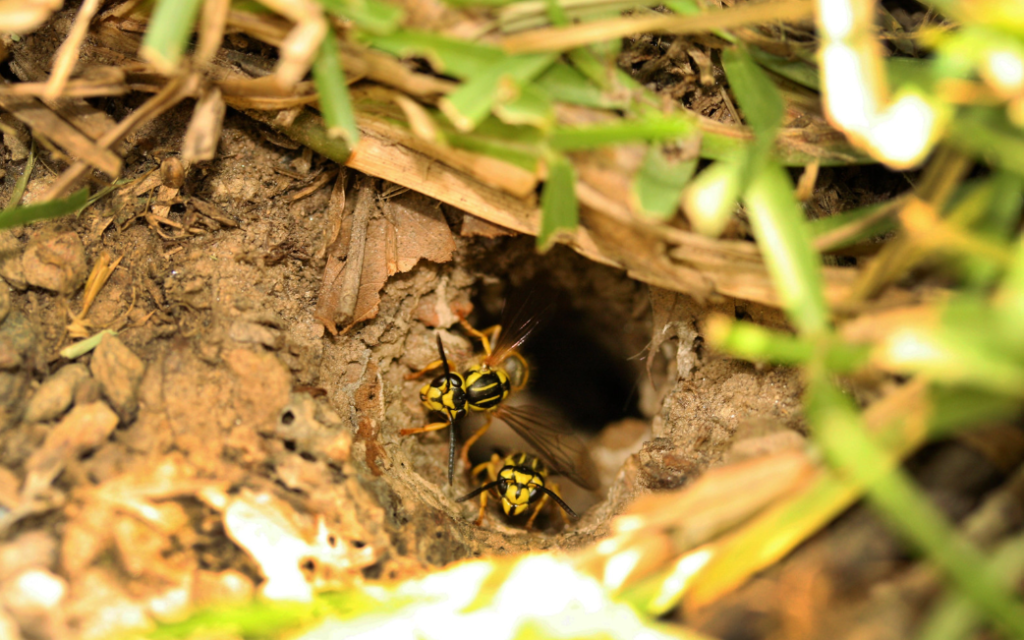
This story begins with a wounded snake near my camper. I found their small belly-up body barely moving, probably attacked by a cat or less likely a raptor. I debated whether it would be good to kill them to relieve the suffering of a drawn out death. I quickly went to get some tobacco and came back to make some prayers. Soon after, the snake was attended by several yellowjackets, followed shortly by quite a large crowd of them. They had moved the snake’s body off the main path and were feeding on it, covering every inch of the creature, chewing off pieces of meat, perhaps to deliver back to their nest. A few hours later, I returned to find the snake a gray and dry shriveled husk, devoured and transformed by these yellowjackets.
As spring turned to early summer, we began to count the yellowjacket nests as we noticed them. First, I came upon one just near the grave of a recently buried pet. I went to water the tree there, and was drawn by curiosity to a big hole nearby. Not even stopping to think, I went over and leaned my face right down over the hole, wondering about the pretty papery material I was looking at. The realization that I was doing something very dumb came out along with a couple of peeved yellowjackets who proceeded to chase me away. They sure buzzed around my head and I sure ran inside, but I didn’t get stung.
More ground nests made themselves apparent: one in the nursery, two in the garden, one at the base of the well hydrant. We worried over the one in the nursery first, as it was located in an area that would see regular traffic in order to weed and water the plants, and to allow customers to browse. Many a heated conversation ensued about what to do about this. We don’t want to kill unless absolutely necessary, yet it seemed like we would not be able to do our nursery work with this nest right there. My partner suggested flooding the nest with water, which I agreed to. I feel a little ashamed recounting these memories, having had more time to reflect now on what actually happened.
Night after night he attempted to flood out the nest, but each morning the yellowjackets would still be there, buzzing and rebuilding. I waffled between thinking we should apologize to the yellowjackets and just try to keep the peace, and escalating our extermination attempts. I watched many Youtube videos about how other people get rid of yellowjacket nests. Fire? Gasoline? Insecticidal dust? The days went by and we took note that none of us were actually getting hurt or stung. Sure, we were always extremely cautious and vigilant around the nest, moving slowly, and giving it a wide berth, finding ways to water the plants in the area from a further distance. Sometimes a yellowjacket would “bump” us as we were working in the nursery, but no stings. I noticed that often, while working in other areas of the garden, when pruning vines or digging up “weeds” to plant a new crop, the yellowjackets became extremely curious and would come over to check out what I was doing. Again, they didn’t sting me, but would crawl all over the plants I had freshly cut or unearthed. I wondered what about this was attracting them: pheromones, phytochemicals, the energy of change or the life/death/life cycle? It could also just be a coincidence, I suppose.
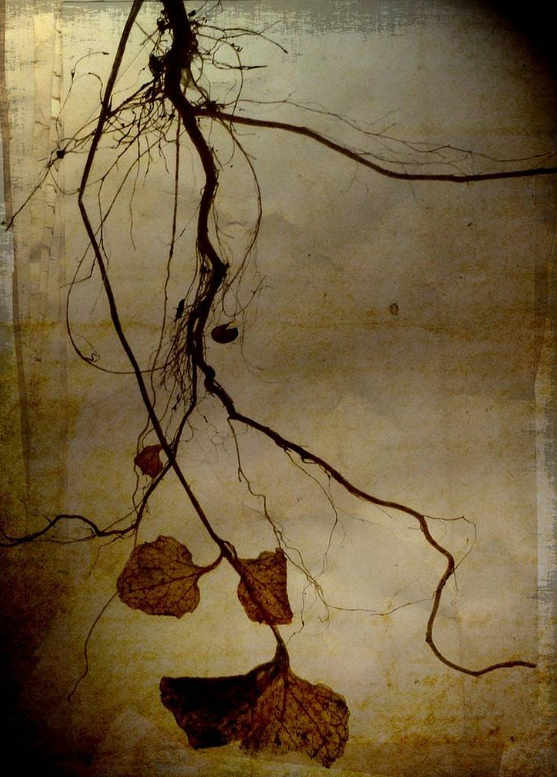
Around midsummer I was working with my friend Meg on an event we would soon be holding on the land, and explaining the situation with the yellowjackets and my concerns about them. I remember her talking about regarding yellowjackets as connected to the “Plutonic” and “Underworld” – or something along those lines. I’m not an astrologer or an expert on mythology, but those themes of death and transformation did seem to connect with my contextual observations so far.
My intense and emotional focus shifted to the two nests sandwiching the flower and herb circle/spiral and the frog pond. I discovered one when attempting to weed through thyme crawling over some stones, revealing the trailing activity of yellowjackets coming and going through the stones. Then, I wanted to move an old pot sitting next to the Mountain Mint growing near the pond, so that I could do some cleaning and weeding. I moved the pot just a little, which again revealed the humming comings and goings of the winged insects, up and down, in and out of the ground. I was surprised in both instances that I hadn’t really noticed these nests until moving something near them. I had walked through both of those areas frequently. Then again, it could have just been the timing of the year, the season’s increasing warmth, and the typical growth in nest size and activity over the course of the summer.
The emotional intensity that ensued surprised me. I was convinced that there was no way for me to safely work in that part of the garden at all. How would I tend the Passionflower vines that were quickly beginning to swallow everything else in the area? I felt so angry and powerless – “I can’t even work in my own garden!” To which my partner reminded me – you know, this isn’t “our” land? Which I acknowledged on some level, but still fought tooth and nail against, activated nervous system swayed by all the Youtube videos encouraging me to “reclaim my territory.” I was starting to come around to these video personalities’ suggestions of either gasoline and fire or putting peanut butter near the nests to attract bears or skunks to eat them. It seemed like I was beginning to convince my partner too that maybe we did need to get rid of these nests once and for all. My nervous system was oscillating between a very aroused state of anger and wanting to fight, and a very depressed and powerless state of having no enthusiasm to tend the garden anymore. This activation in my nervous system illuminated my own cognitive dissonances and places of misalignment caused by the emotional reactivity. Generally, I do not want to give in to the anthropocentric species narcissism so common in our culture, for I know my needs are not greater than those of other beings. But in those moments, I could only focus on my need for safety, security, and ease, ignoring others’ need to live. That is the power of fear, I guess. And propaganda that feeds that fear, like stereotypes that yellowjackets are merely inherently nasty beings.
I guess it was partially the pull of the Passionflower that helped me discover a different relationship to all this. I wanted to dig up some of the running vines to pot up for the nursery stock (and to deter them from taking over the whole garden), and I also wanted to make a big batch of medicine, having a feeling that it would be needed for my community soon. Following the pull of the Passionflower, I decided to try working in that area of the garden, very slowly and cautiously to find out what would happen. And as you might be guessing, the yellowjackets did not bother me at all! Moving slowly, intentionally, and calmly was good not only for my own safety and the peace of mind of the wasps, but also for the processes of digging up plants and harvesting medicine. It turned out that I could, in fact, work in the garden and not have to exterminate the yellowjackets in order to do so. In retrospect, I wonder if this context of mindfully harvesting this wonderful nervine/relaxant medicine in such a delicate and potentially stressful situation has influenced the medicine at all. At the very least it is a bit situationally poetic. Renée Camila, one of my current herbal teachers at the Now and Then Herb School, recently was teaching about the various personalities of herbs with affinities for nervous system support. While Passionflower is usually known generically as an anti-anxiety sleep aid, her specific acknowledgment of Passionflower’s ability to help “integrate the spaces within tension” and to soften binaries stood out to me. She shared further with me that “truth exists in liminal spaces, in the both/and spaces, in the possibility of teachings within the ‘shadow’ work that comes with relaxation.” This all reminds me of the tension of the nests on all sides, yet finding a new and more relaxed spaciousness to harvest the medicine and integrate the polarities of the situation. I continue to feel also that Passionflower’s medicine can teach us and guide us in these collectively turbulent and liminal times.
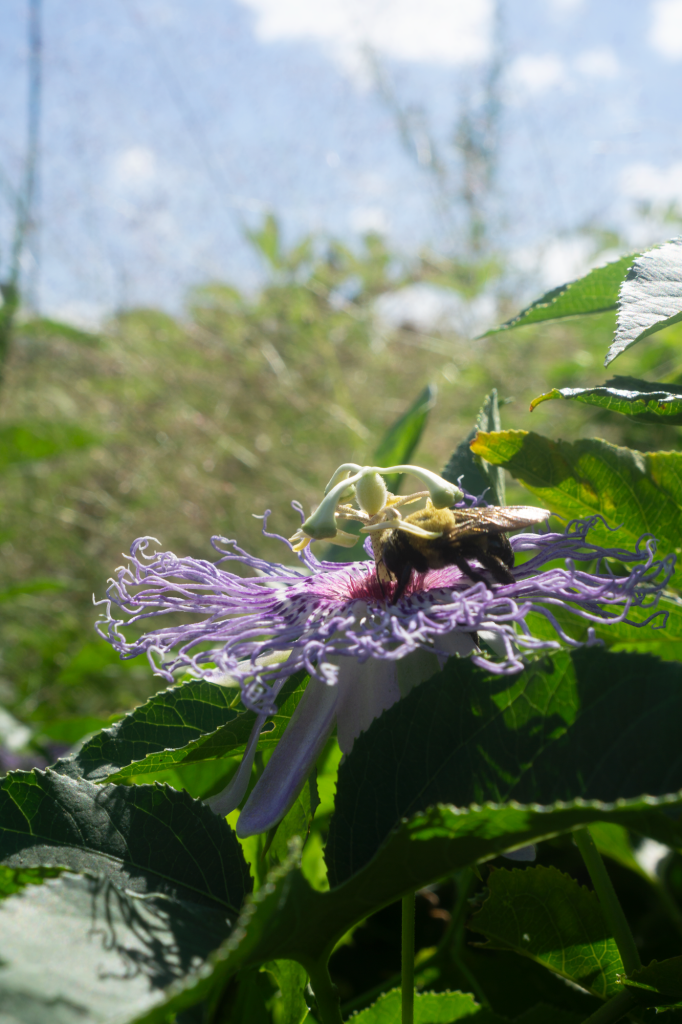
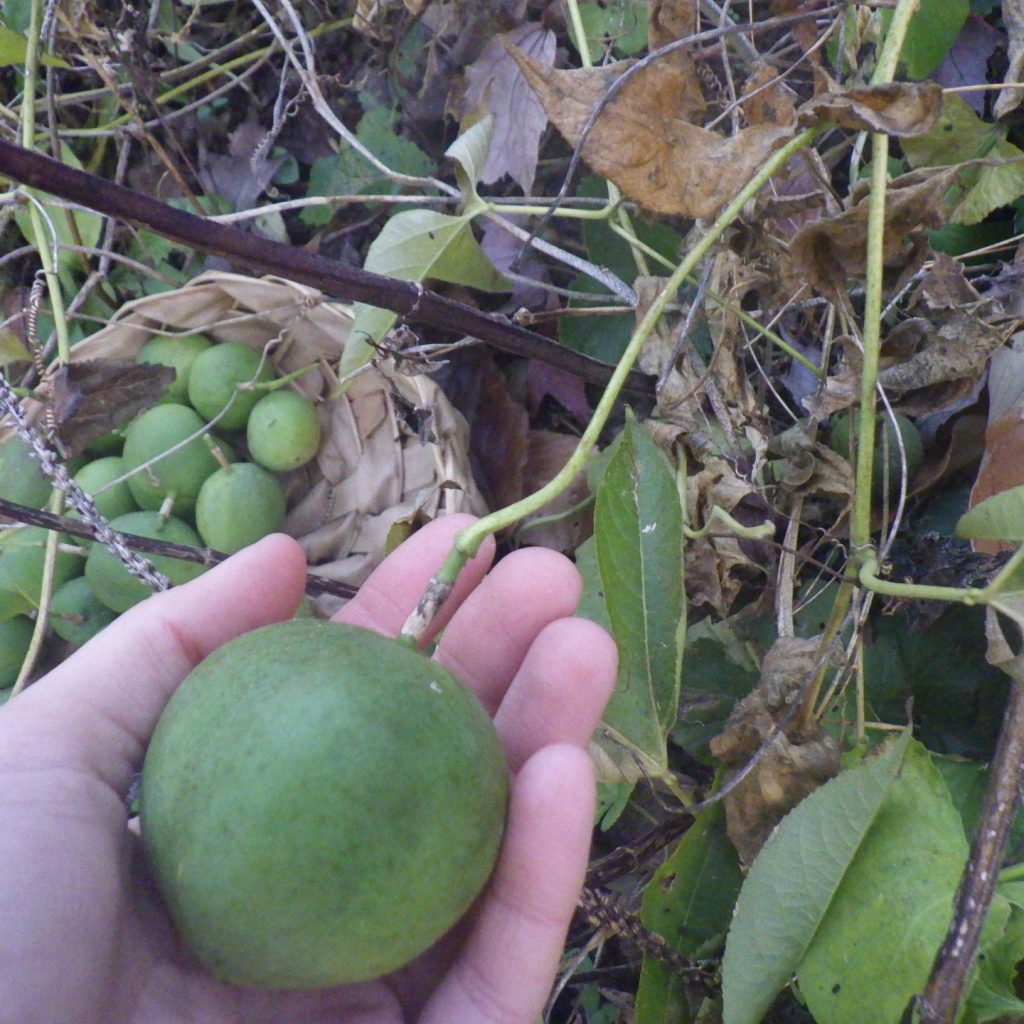
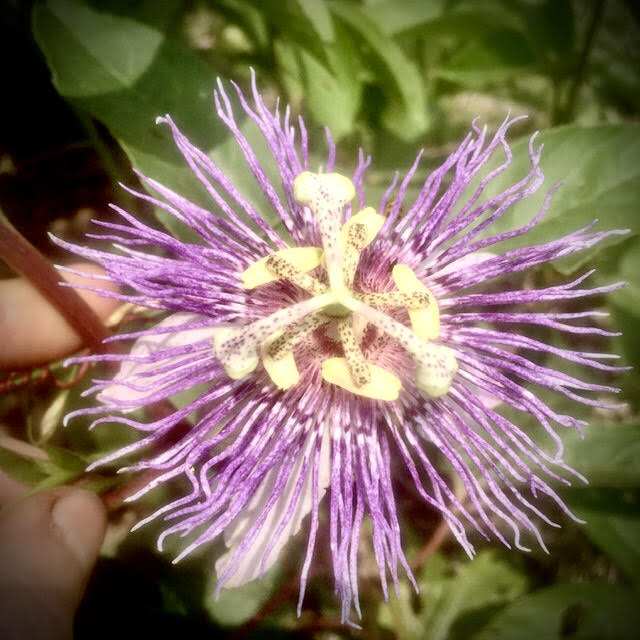
With the experiences in the garden and the nursery now providing embodied evidence that we could, in fact, coexist fairly peacefully with the yellowjackets, my inner landscape finally began to change. I became more solid in our decision to leave the nests be. All through the rest of the season they continued to do us no harm. I do not think yellowjackets live up to their angry or aggressive stereotype. They are extremely protective and nurturing of their young, developing in their little cells, which is why they are prone to attack if you are being careless or aggressive near their nest. Perhaps different colonies of yellowjackets have different personalities, some more or less belligerent than others in different situations. Later in the summer, walking by the pet’s grave, I noticed there was no more wasp movement coming from that particular nest. I dared to peek my head near the hole again, and didn’t even see any nest remnants. Perhaps a bear did enjoy eating it after all, no peanut butter bait needed. We have noted Bear walking through that area of the land, so it is very possible.
There was no trouble when folks came to visit our place. We put flags near the remaining nests so that people would be aware of them and not get too close or move too quickly. I listened to a lot of science podcasts to learn more about yellowjackets, their biology, social behavior, and cycles. The event that Meg and I led went fine. Long afterwards in late fall, I was in a clearing in the woods where we had circled up to do a plant meditation/journey during the event. I was trying to dismantle and remove some bits of plastic tubing sticking out of the ground nearby (remnants of the previous owners’ water diversion projects), part of the endless effort to keep cleaning old trash that turns up. The long tubing was becoming part of the land, buried over with soil and with roots growing through it now. I was finding it challenging to remove any of it, and hesitating to re-disturb the whole area. Then I noticed sleepy yellowjackets coming in and out of a piece of tubing I was about to grab. I couldn’t believe there was another nest right there, and hadn’t noticed it at all during the event a couple months earlier. So, I let the nest be, and the plastic tubing that creatures had figured out how to turn into homes. I could glimpse a little bit of the nest itself inside, so I made a plan to come back in winter after a couple of deep freezes, because I was really curious to see close up how they construct their nests.
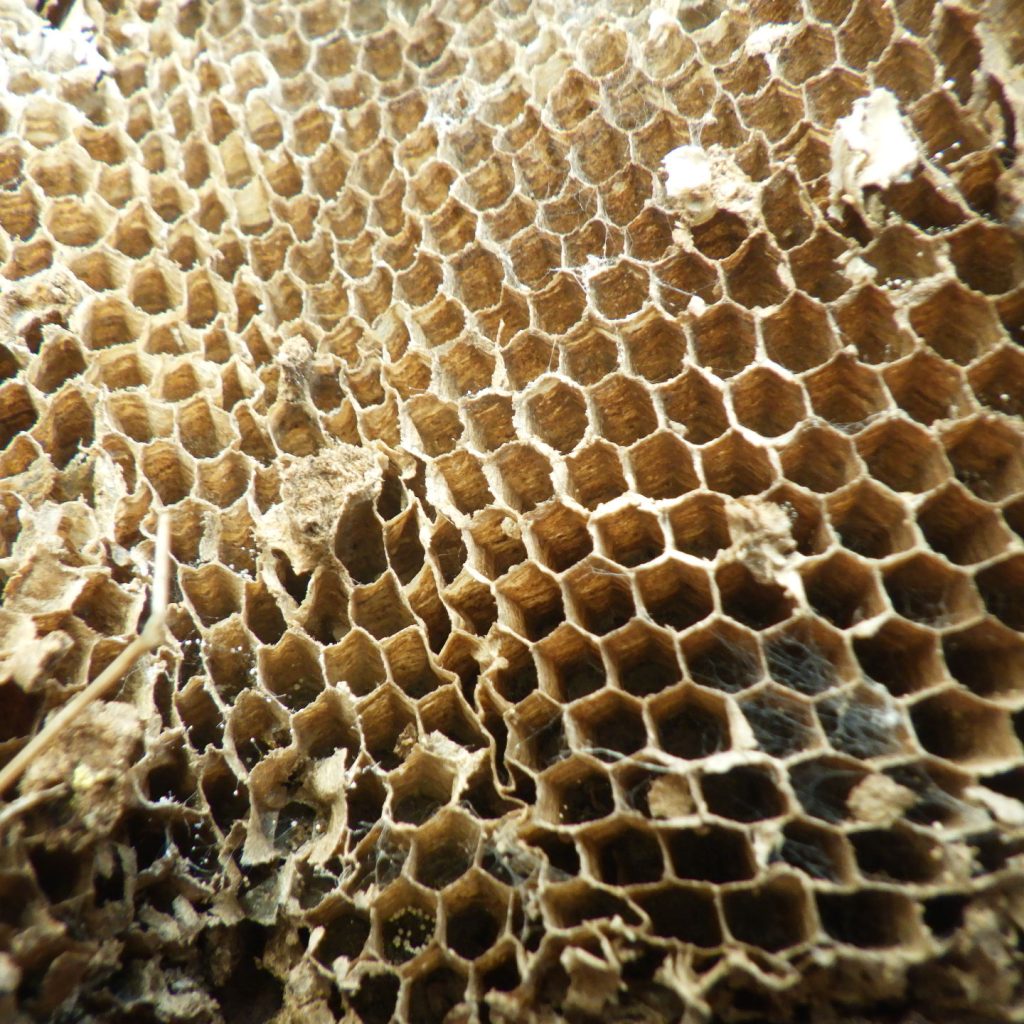
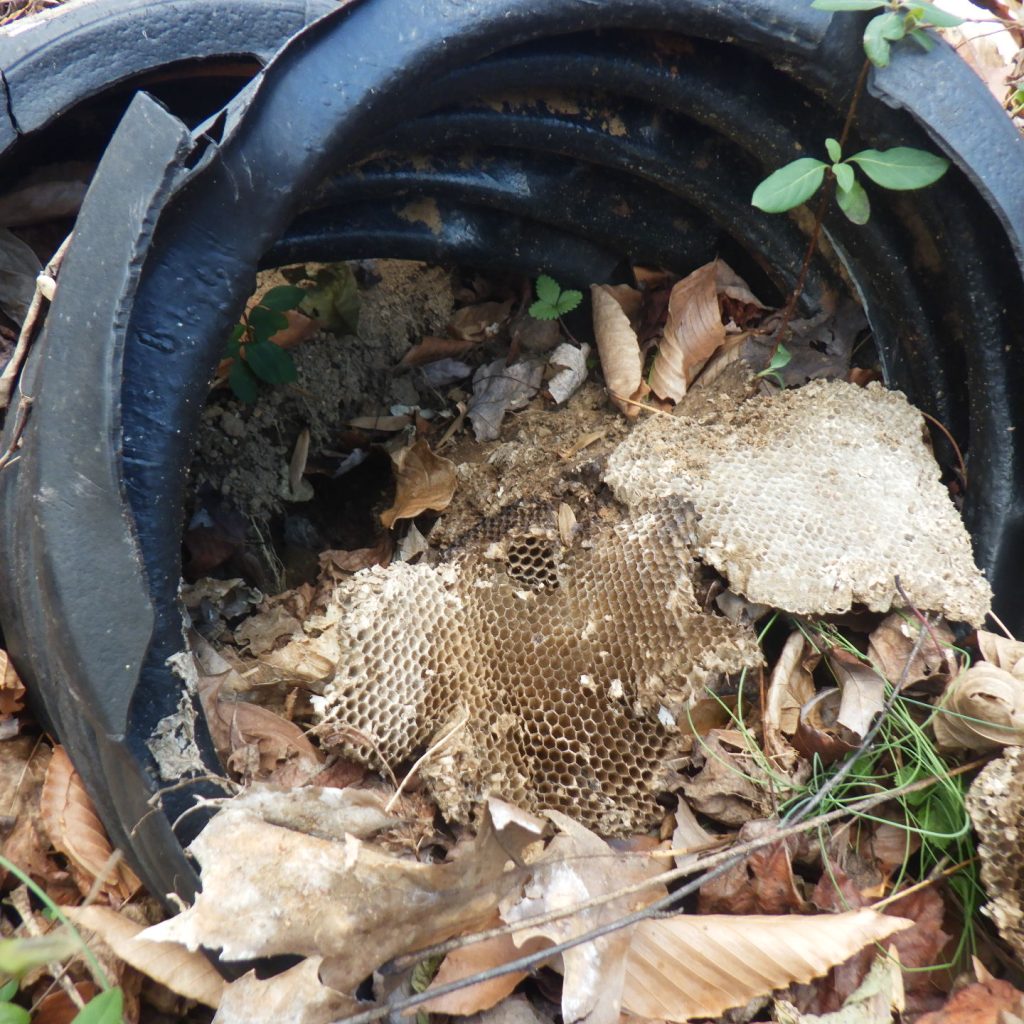
I had another memorable fall experience at a location where I do some gardening/landscaping work for a client. They have lovely and robust Jujube trees planted near a narrow body of water near the house. One day, I was to clean up the fallen and fermenting jujubes, both out of other garden beds where they didn’t want more Jujube trees growing and also from the rather stagnant water. The smell in the air that day as I was working can best be described as a blend of beer and vomit, the aroma of a frat house carpet the morning after homecoming. The yellowjacket workers and drones were having their last go at life, very drunk on the sickly sweet Jujube ferment, some of them dying atop that rotting fruit. We know that death is an aspect of the Plutonic archetype and the Underworld, but perhaps drunkenness dwells somewhere near that realm too. Dionysus now comes to mind, often thought of as the God of Wine and Ecstasy, but so much more complex than that. As Nyx Shadowhawk writes in their article, Who is Dionysus:
“As the god of viticulture, Dionysus’ dual nature manifests a bit differently. Outside of Athens, he was worshipped over a two-year period, in which he entered into a Persephone-like dynamic with himself. The “dark” or chthonic Dionysus is Zagreus or Dionysos Meilichios, represented by a figwood mask. This is a mild, gentle, somber version of himself that is absent for the first year, and represents the fermentation stage of winemaking.
At the end of the year when the wine is opened, he is replaced with the bright, wild, ecstatic version of himself with all the joy and ferocity that it implies — Dionysos Bakkhos, the frenzied, or Bromios, the loud. The figwood mask that represents him would be replaced by a vinewood mask. This version of him is present, and represents pure, unrestrained life-force. As an embodiment of life-force, Dionysus is able to transcend death; he died and was resurrected himself, and descended into the Underworld to rescue the souls of his wife and mother, making him responsible for the apotheosis of two mortals. During the Athenian festival of Anthesteria… he leads the dead up from Hades in a procession of souls to revel with living humans for three days.
…Dionysus is a god of liminality — the space between human and divine, between sane and insane, between sensual and spiritual, between male and female, between life and death, both above and below.”
As I worked in that strange harmony and disharmony of death and drunkenness, I noticed that I felt sad for the yellowjackets, empathizing with their situation as the cold winter began to creep closer. They were so tired and/or drunk that any remaining live ones of course did not sting me, or perhaps even really notice me. What a change from earlier in the year, what a transformation of anger, depression, and destructive drives to curiosity and empathy for these beings. Incidentally, I also learned recently that Jujube in Traditional Chinese Medicine is, like Passionflower, often used to support calming the mind and spirit. Perhaps just another coincidence. But I wonder now if yellowjackets that live near or ingest medicinal plants such as these nervines might be overall more relaxed and easier to coexist with.
Now that winter is here and we’ve had some very cold nights, I went back to visit the nest in the plastic tubing, now vacant. I gave an offering, felt a strangely deep connection and opening in my heart, and was able to hold the nest in my hands. I admired their precision of architecture and imagined the visceral process of creating this nursery using just wood pulp and one’s own body. I felt a pleasant buzzing in my hand as I held it, perhaps a memory of all the nurturing, doting, concern, and wriggling growth and metamorphosis that happened in that nest. More curiosities arose about “stigmergy,” the coordination processes of these social insects. “The basic principle of stigmergy is extremely simple: Traces left and modifications made by individuals in their environment may feed back on them. The colony records its activity in part in the physical environment and uses this record to organize collective behavior. Various forms of storage are used: gradients of pheromones, material structures (impregnated or not by chemical compounds), or spatial distribution of colony elements. Such structures materialize the dynamics of the colony’s collective behavior and constrain the behavior of individuals through a feedback loop. Stigmergy also solves the coordination paradox: Individuals do interact to achieve coordination but they interact indirectly, so that each insect taken separately does not seem to be involved in a coordinated, collective behavior.” (A Brief History of Stigmergy)
Could stigmergy be somehow applied to human modes of group decision-making or large-scale action?
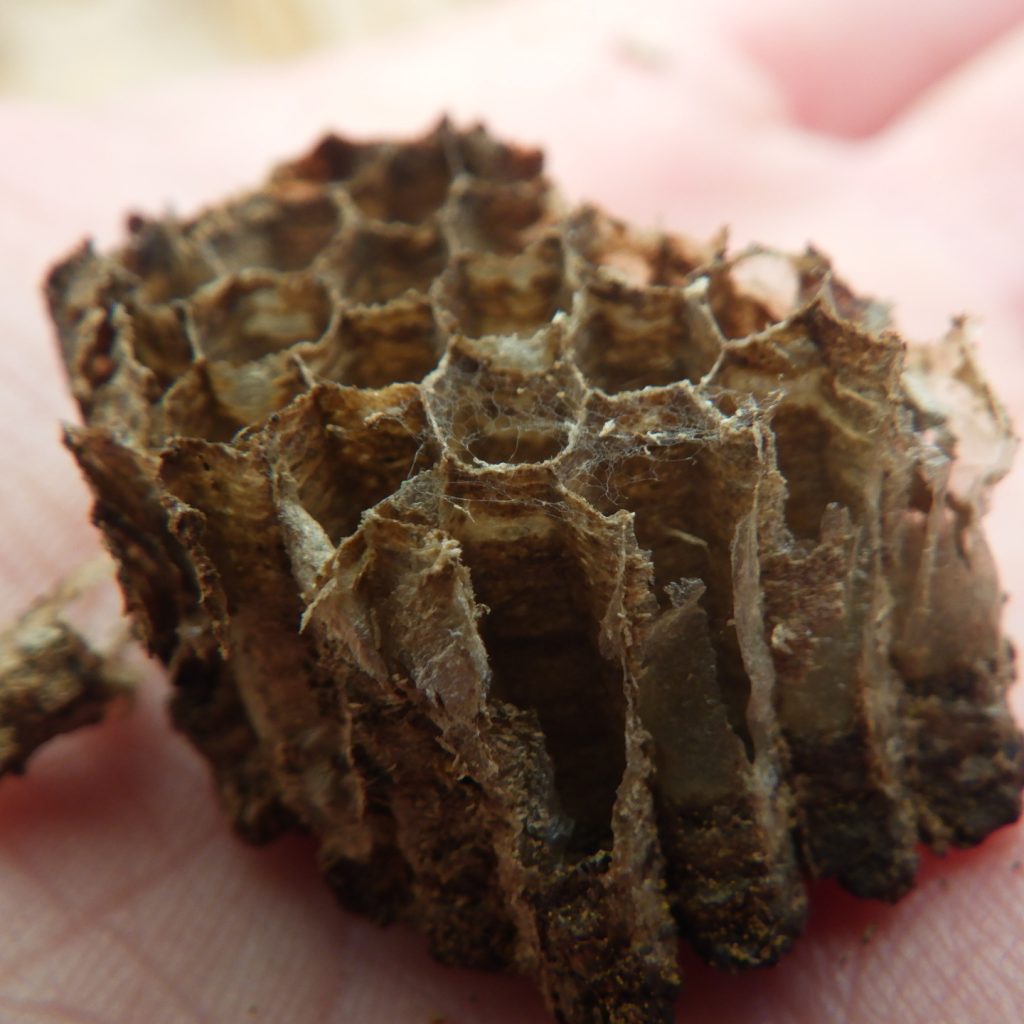
Last weekend, during a brief winter’s thaw, I dropped some seeds off at Wild Altar Farmstead’s market stand. They had a jar of jam open for tasting, and a rather slow moving yellowjacket went into the jar to enjoy the treat. I almost cried, because I was actually happy to see them. That sure surprised me, and the folks at the stand too. Whoever heard of anyone feeling joyful to see a yellowjacket?! I had only recently connected with the closure of a cycle, feeling the season of goodbyes, not expecting to see more yellowjacket workers. I had thought that most of them would have died in the freezes, unless they were a queen (who is usually the sole survivor over the winter), and this one was not a queen. A little nod to Dionysian-style transcendence of death? Later in the day, I realized that sometimes yellowjackets and other wasps make their nests in warmer or more protected places, allowing them to survive through the winter. This led me to an article about “super nests” in Alabama in 2019…can you imagine an old garage with a yellowjacket nest that fills up the entire interior of a car? Warmer winters will cause less mortality in the worker population that normally dies in the hard frosts, so the nest can continue to grow. This can explain why the year after a mild winter there might be an exceptionally large population of wasps. Almost everyone I spoke to said they also saw more yellowjackets this year than in recent years. Perhaps the droughty conditions of the past several seasons also had something to do with it. Maybe it was just a Plutonic, Underworld-y kind of year…I know for me personally, it was a bit of a hellish and liminal cycle of seasons. Not without its celebratory or beautiful moments, but lots of grief, change, and frustration in the mix. Taking a look around at different parts of the globe, our own country included, that might track collectively, too: widespread war, genocide, fascism on the rise- but also more widespread consciousness and fierce devotion to liberation for all oppressed.
I step outside as I write this, grateful for the warmth and the rain today in a dry and chilly December. I wonder where the yellowjacket queens are hibernating alone for the winter, what they dream about, and where they will choose to begin the new nests next year. How will the increasingly erratic climate influence the seasonal patterns of growth and decline in yellowjacket and other insect populations? The wind blows loud and constant over the hills, and an old volunteer Datura stalk growing out of the compost pile glimmers on this grey day. It almost feels as if they are winking at me. Datura, with their hallucinogenic and poisonous and sacred aspects, also has a long association with realms of death/rebirth and intense transformation. Datura, do you know where we are in this collective Underworld journey, and what it would take to see the light of day again?
